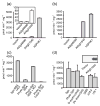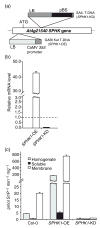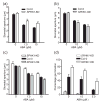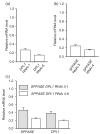Involvement of sphingosine kinase in plant cell signalling
- PMID: 18557834
- PMCID: PMC2752831
- DOI: 10.1111/j.1365-313X.2008.03579.x
Involvement of sphingosine kinase in plant cell signalling
Abstract
In mammalian cells sphingosine-1-phosphate (S1P) is a well-established messenger molecule that participates in a wide range of signalling pathways. The objective of the work reported here was to investigate the extent to which phosphorylated long-chain sphingoid bases, such as sphingosine-1-phosphate and phytosphingosine-1-phosphate (phytoS1P) are used in plant cell signalling. To do this, we manipulated Arabidopsis genes capable of metabolizing these messenger molecules. We show that Sphingosine kinase1 (SPHK1) encodes an enzyme that phosphorylates sphingosine, phytosphingosine and other sphingoid long-chain bases. The stomata of SPHK1-KD Arabidopsis plants were less sensitive, whereas the stomata of SPHK1-OE plants were more sensitive, than wild type to ABA. The rate of germination of SPHK1-KD was enhanced, whereas the converse was true for SPHK1-OE seed. Reducing expression of either the putative Arabidopsis S1P phosphatase (SPPASE) or the DPL1 gene, which encodes an enzyme with S1P lyase activity, individually, had no effect on guard-cell ABA signalling; however, stomatal responses to ABA in SPPASEDPL1 RNAi plants were compromised. Reducing the expression of DPL1 had no effect on germination; however, germination of SPPASE RNAi seeds was more sensitive to applied ABA. We also found evidence that expression of SPHK1 and SPPASE were coordinately regulated, and discuss how this might contribute to robustness in guard-cell signalling. In summary, our data establish SPHK1 as a component in two separate plant signalling systems, opening the possibility that phosphorylated long-chain sphingoid bases such as S1P and phytoS1P are ubiquitous messengers in plants.
Figures






Similar articles
-
Connections between sphingosine kinase and phospholipase D in the abscisic acid signaling pathway in Arabidopsis.J Biol Chem. 2012 Mar 9;287(11):8286-96. doi: 10.1074/jbc.M111.274274. Epub 2012 Jan 24. J Biol Chem. 2012. PMID: 22275366 Free PMC article.
-
Arabidopsis sphingosine kinase and the effects of phytosphingosine-1-phosphate on stomatal aperture.Plant Physiol. 2005 Feb;137(2):724-37. doi: 10.1104/pp.104.055806. Epub 2005 Jan 21. Plant Physiol. 2005. PMID: 15665242 Free PMC article.
-
Sphingolipid signalling in Arabidopsis guard cells involves heterotrimeric G proteins.Nature. 2003 Jun 5;423(6940):651-4. doi: 10.1038/nature01643. Nature. 2003. PMID: 12789341
-
Epigenetic regulation of pro-inflammatory cytokine secretion by sphingosine 1-phosphate (S1P) in acute lung injury: Role of S1P lyase.Adv Biol Regul. 2017 Jan;63:156-166. doi: 10.1016/j.jbior.2016.09.007. Epub 2016 Sep 29. Adv Biol Regul. 2017. PMID: 27720306 Free PMC article. Review.
-
Translational aspects of sphingosine 1-phosphate biology.Trends Mol Med. 2011 Aug;17(8):463-72. doi: 10.1016/j.molmed.2011.03.002. Epub 2011 Apr 21. Trends Mol Med. 2011. PMID: 21514226 Review.
Cited by
-
Comparative Metabolomics Analysis Reveals Sterols and Sphingolipids Play a Role in Cotton Fiber Cell Initiation.Int J Mol Sci. 2021 Oct 23;22(21):11438. doi: 10.3390/ijms222111438. Int J Mol Sci. 2021. PMID: 34768870 Free PMC article.
-
Ethylene Modulates Sphingolipid Synthesis in Arabidopsis.Front Plant Sci. 2015 Dec 16;6:1122. doi: 10.3389/fpls.2015.01122. eCollection 2015. Front Plant Sci. 2015. PMID: 26734030 Free PMC article.
-
Sphingolipids and plant defense/disease: the "death" connection and beyond.Front Plant Sci. 2012 Apr 10;3:68. doi: 10.3389/fpls.2012.00068. eCollection 2012. Front Plant Sci. 2012. PMID: 22639658 Free PMC article.
-
GLUCOSAMINE INOSITOLPHOSPHORYLCERAMIDE TRANSFERASE1 (GINT1) Is a GlcNAc-Containing Glycosylinositol Phosphorylceramide Glycosyltransferase.Plant Physiol. 2018 Jul;177(3):938-952. doi: 10.1104/pp.18.00396. Epub 2018 May 14. Plant Physiol. 2018. PMID: 29760197 Free PMC article.
-
Molecular Characterization of Rice OsLCB2a1 Gene and Functional Analysis of its Role in Insect Resistance.Front Plant Sci. 2016 Dec 1;7:1789. doi: 10.3389/fpls.2016.01789. eCollection 2016. Front Plant Sci. 2016. PMID: 27990147 Free PMC article.
References
-
- Chalfant CE, Spiegel S. Sphingosine 1-phosphate and ceramide 1-phosphate: expanding roles in cell signalling. J Cell Sci. 2005;118:4605–4612. - PubMed
-
- Clough SJ, Bent AF. Floral dip: a simplified method for Agrobacterium-mediated transformation of Arabidopsis thaliana. Plant J. 1998;16:735–743. - PubMed
-
- Coursol S, Fan LM, Le Stunff H, Spiegel S, Gilroy S, Assmann SM. Sphingolipid signalling in Arabidopsis guard cells involves heterotrimeric G proteins. Nature. 2003;423:651–654. - PubMed
-
- Crawley MJ. GLIM for Ecologists. Oxford: Blackwell Scientific; 1993.
Publication types
MeSH terms
Substances
Grants and funding
LinkOut - more resources
Full Text Sources
Other Literature Sources
Molecular Biology Databases

